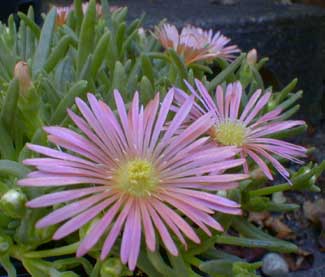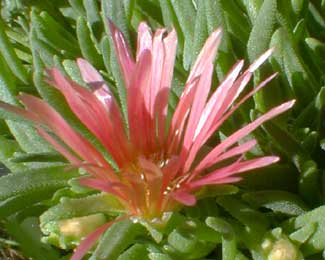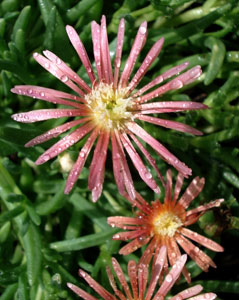
'Kelaidis'
Mesa Verde Trailing Iceplant
"My hips
slipped into the flat line of the
equator. You basking under
your tiara of succulents
on a stone, toying with a stone."
-Ben Doyle,
b. 1973
b. 1973
 In 1998, this color varient of the hardy trailing ice plant appeared spontaneously as a seedling mutation at the Denver Botanic Gardens. It is believed to be Delosperma cooperi serendipitously pollinated by D. nubigenum.
In 1998, this color varient of the hardy trailing ice plant appeared spontaneously as a seedling mutation at the Denver Botanic Gardens. It is believed to be Delosperma cooperi serendipitously pollinated by D. nubigenum.Its cultivar name is 'Kelaidis' after Panayoti Kelaidis, Curator of Plant Collections at the Denver Botanic Gardens, & designer of of the Botanic Gardens' world-famed Rock Alpine Garden. But commerce cares nothing about deserved honors, so it was additionally provided with the trademark name 'Mesa Verde' for marketing purposes.
The name 'Mesa Verde' might be apropos for its literal meaning "green table," since iceplants form green mats, but as it evokes Colorado's Mesa Verde National Forest, it's actually a pretty inapropos cultivar name, since ice plants are native to South Africa.
I have rarely seen nursery distributors balk at the imposition of a marketing name, since they are usually easily pronouced sometimes quite discriptive or pretty names. But in this case enough people know about Dr. Kelaidis' very important work that has resulted in newly introduced hardy iceplants for garden centers everywhere, so that many catalogs make a point of noting Mesa Verde is actually named 'Kelaidis.'
 'Kelaidis' Mesa Verde ice plant forms a thick continuous succulent mat two to six inches thick, sometimes clumping higher.
'Kelaidis' Mesa Verde ice plant forms a thick continuous succulent mat two to six inches thick, sometimes clumping higher.The shimmering almost metallic salmon-pink flowers are present all summer long, generally in two or three shades as if there were more than one variety in the same spreading carpet. The flowers are open only in full sun & close up evenings or on heavily overcast days or in shade, so they should never be planted in shade.
It prefers sandy poor soil in fullest sun & rarely need watering. Wetness especially in winter will kill it, but in sharply draining soil it will be vigorous & spread rapidly, with a thick root-system that out-competes the majority of weeds. They will also overrun similar groundcovers like sedums, so take care of what is selected as iceplant companions.
The first time I planted this variety, it didn't make it through a winter of heavy rains, as soggy soil is its one bane. I planted it again in soil I hope will drain more sharply in our autumn & winter deluges, & with fingers crossed do expect good luck.
The succulent leaves of D. cooperi were traditionally used by the Bantu people to make khadi, a beer-like alcoholic beverage, despite that the plant can be toxic. The roots were dug up by white settlers in South Africa as a source of yeast.